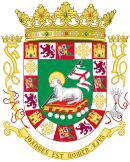Government of the Commonwealth of Puerto Rico | |
|---|---|
 | |
| Part of | United States of America |
| Constitution | Constitution of Puerto Rico |
| Legislative branch | |
| Name | Legislative Assembly |
| Type | Bicameral |
| Meeting place | Puerto Rico Capitol |
| Upper house | |
| Name | Senate |
| Presiding officer | José Luis Dalmau, President |
| Lower house | |
| Name | House of Representatives |
| Presiding officer | Tatito Hernández, Speaker |
| Executive branch | |
| Head of state and government | |
| Title | Governor |
| Currently | Pedro Pierluisi |
| Appointer | Election |
| Cabinet | |
| Name | Cabinet of the Commonwealth of Puerto Rico |
| Leader | Governor |
| Headquarters | La Fortaleza |
| Judicial branch | |
| Name | Judiciary of Puerto Rico |
| Courts | Courts of Puerto Rico |
| Puerto Rico Supreme Court | |
| Chief judge | Maite Oronoz Rodríguez |
| Seat | San Juan |
 |
|---|
The government of the Commonwealth of Puerto Rico is a republican democracy established by the Constitution of Puerto Rico in 1952. Under a system of separation of powers, the government is divided among three branches: the executive, the legislative, and the judicial. As a territory of the United States, the government of Puerto Rico is under the jurisdiction of the federal government of the United States.
Article I of the Constitution of Puerto Rico defines the government of Puerto Rico as a republican form of government seated in San Juan with executive, legislative, and judicial powers within the archipelago and island of Puerto Rico.
Article IV defines the executive branch as headed by the governor, currently Pedro Pierluisi, who is also the head of government. Article III defines the legislative branch as consisting of a bicameral legislature, namely the Legislative Assembly, composed by the Senate as its upper house and by the House of Representatives as its lower house. The governor and legislators are elected by popular vote every four years.
Article V defines the judicial branch as headed by the Chief Justice of the Supreme Court of Puerto Rico, currently Maite Oronoz Rodríguez. The legal system is a mixture of the civil law and the common law systems. Members of the judicial branch are appointed by the governor with advice and consent from the Senate.
The extent of the powers of the government of Puerto Rico and the rights of the citizens of Puerto Rico as enumerated in the Constitution of Puerto Rico and the laws of Puerto Rico are subject to the authority of the Constitution of the United States and the laws of the United States, which are enacted and amended by the Congress of the United States, executed and enforced by the President of the United States, and interpreted and validated by the Supreme Court of the United States. Puerto Rico is subject to the jurisdiction of the federal government of the United States and the territorial sovereignty of the United States.[1][2][3] Its head of state is the president of the United States, currently Joe Biden.
As an unincorporated territory of the United States, Puerto Rico is neither a sovereign state nor a state of the United States. The federal government of the United States has enumerated powers, including monetary policy, foreign relations, and defense. The local government of Puerto Rico has reserved powers, including education, law enforcement, and elections. Both governments share concurrent powers, including taxation and fiscal policy. The political status of Puerto Rico is an ongoing debate.